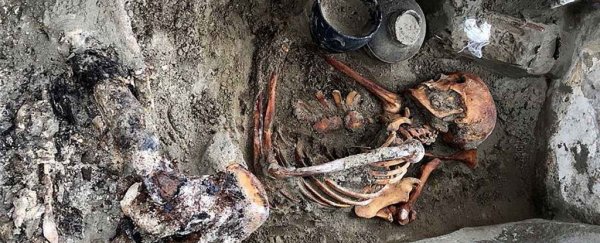Archaeologists in southern Siberia have unearthed a remarkable find - the mummified remains of a woman, carefully adorned in silk and buried with riches. Miraculously, her resting place was unscathed after being underwater for many years.
The team spotted the grave on the bank of the Yenisei River upstream of a giant dam - in a region that had been periodically underwater for decades.
She's been nicknamed "sleeping beauty", and was probably buried sometime in around the first century CE, archaeologists from St Petersburg's Institute for the History of Material Culture believe.
Her burial place is near the Sayano-Shushenskaya Dam, which powers a hydroelectric power plant, and had been underwater for a great deal of time since the 1980s, when the reservoir began to be filled.
But her burial was unusual - she was laid to rest in a stone coffin - which is how her remains managed to survive being flooded.
"The mummy of a young woman was found inside a grave at the burial ground Terezin on the shore of a water reservoir. The lower part of the body is well-preserved," explained archaeologist Marina Kilunovskaya of the Institute to Russian news agency TASS.
"It is not a classical mummy, though. The grave remained tightly sealed under the stone cover all along. The body underwent natural mummification."
The waters recede every May and June, which allows archaeologists a short period of time to access the archaeological sites that were covered by the reservoir. They opened the tomb in May this year.
Inside, the burial was exceptionally well preserved. Soft tissues, skin, clothing and even grave goods were all found intact.
And the clothing and grave goods hint that the lady was a nomadic Hun, young and highly regarded by her people, possibly a noble.
"On the mummy are what we believe to be silk clothes, a beaded belt with a jet buckle, apparently with a pattern," the Institute's deputy director, Natalya Solovieva, told The Siberian Times.
"Near the head was found a round wooden box covered with birch-bark in which lay a Chinese mirror in a felt case."
There were also two vessels buried with her, one of which was a typical Hun vase, both containing a funeral meal, and on her chest was a pouch of pine nuts. Ceramic utensils in the grave were typical of Hun burial practices, the archaeologists said.
Accidental mummification is not uncommon.
Ötzi the Iceman's body dehydrated, mummified by the ice of the glacier in which it resided for 5,000 years. The Gebelein mummies were naturally mummified by the heat, salinity and dryness of the Egyptian desert.
Bodies have even been found accidentally mummified by their copper grave goods.
Further work will need to be undertaken to determine exactly how the Sleeping Beauty was so well preserved. It's also expected that analysis of her body and grave goods will reveal a lot about her culture, and her own life in particular.
The artefacts and body have been removed from the grave, and restoration experts have already started work to preserve them for posterity.
